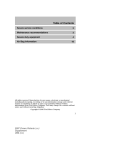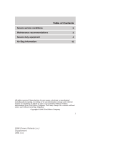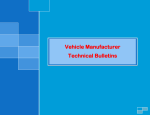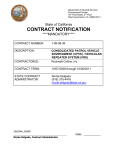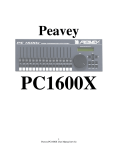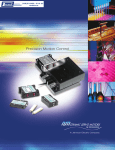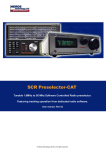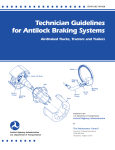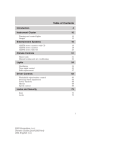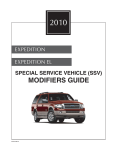Download Table of Contents
Transcript
Table of Contents Severe service conditions 2 Maintenance recommendations 3 Severe duty equipment 4 Airbag Information 18 All rights reserved. Reproduction by any means, electronic or mechanical including photocopying, recording or by any information storage and retrieval system or translation in whole or part is not permitted without written authorization from Ford Motor Company. Ford may change the contents without notice and without incurring obligation. Copyright © 2007 Ford Motor Company 1 2008 Crown Victoria (cro) Supplement USA (fus) Severe service conditions This supplement is intended to aid the operators of police or fleet vehicles (used in severe duty, high mileage operations) in understanding the required maintenance services for such vehicles. It covers maintenance services for vehicles equipped with Heavy Duty packages. However, other vehicles operated under the conditions listed in this supplement are also considered “severe service” vehicles and should be serviced and maintained as prescribed in this brochure. This brochure applies to rear wheel drive passenger cars only. CONTACT US Ford Fleet Hotline - The Ford Fleet Hotline provides police and fleet customers with direct access to Ford Motor Company for fleet sales or service information. The hotline number is (800) 34-FLEET. Ford Fleet Website - Additionally, Ford maintains a website for police and other fleet vehicles. The Ford Fleet website is located at www.fleet.ford.com. 2 2008 Crown Victoria (cro) Supplement USA (fus) Maintenance recommendations Police and fleet vehicles are manufactured with certain heavy-duty parts that are designed specifically for the varying demands and unique requirements under which they are operated. Note: As the police proportion of the Crown Victoria market continues to increase, some of these heavy duty components have become standard across the Crown Victoria line to reduce parts and manufacturing complexity. Components that are part of the option packages are listed below and on the following pages with a brief outline of their major features and their contribution to overall vehicle performance, handling and usage. Failure to maintain your vehicle(s) properly may restrict your warranty coverage, reduce vehicle performance and operational capabilities and adversely affect driver-passenger safety. The severe duty maintenance intervals are listed in the “Service Guide.” The descriptions, specifications and material described in this publication were in effect at the time the publication was approved for printing. Ford Motor Company reserves the right to discontinue models at any time, or change specifications, design or testing procedures without notice and without incurring obligation. 3 2008 Crown Victoria (cro) Supplement USA (fus) Severe duty equipment POWERTRAIN OVERSPEED PROTECTION The powertrain control module (PCM) includes logic to electronically prevent powertrain overspeed in any transmission selector position. TRANSMISSION The police vehicle has a unique high-performance powertrain including transmission and an aluminum driveshaft, which is designed for maximum vehicle performance. Due to the nature of this powertrain, some powertrain noise may be present. Driving in the overdrive cancel mode for prolonged periods at high speeds will deteriorate performance and may cause extensive engine damage. Crown Victoria police vehicles are designed to operate in the (Overdrive) gear selector position while in pursuit. Optimum performance will be obtained in (Overdrive). Operation in the overdrive cancel mode should only be used in situations noted in the “Owner Guide.” Under no circumstances should the aluminum driveshaft be replaced with a steel driveshaft. Doing so will adversely affect vehicle operation which could lead to personal injury. IDLE METER Your vehicle may be equipped with an idle meter to indicate how much time the vehicle is idling in Park or Neutral. The meter is incorporated with the vehicle odometer. Depressing the odometer-reset button once will display the trip odometer (miles followed by a ⬙T⬙ for trip odometer). Depressing the odometer-reset button a second time will display the idle meter (hours followed by an ⬙h⬙ for hours). The idle meter only accumulates time when the vehicle is in Park or Neutral. Displayed time is cumulative for the vehicle. It cannot be reset to zero. Police/Fleet vehicles often experience long periods of idling, during which engine oil will continue to break down but mileage is not accumulated on the odometer. To assist fleet managers in maintaining proper oil change intervals, the idle meter will help determine when an oil change is required. For every hour that the vehicle idles, it has accumulated the equivalent of approximately 33 miles (53 km) of driving. Using the combination of the vehicle odometer and idle meter allows the fleet manager to better determine when the oil needs to be changed. 4 2008 Crown Victoria (cro) Supplement USA (fus) Severe duty equipment Example: When the odometer has accumulated 3,000 miles (4,828 km) and the idle meter shows 61 hours, a 5,000 mile (8047 km) oil change interval will have been reached: 3,000 road miles + (61 idle hours x 33 miles/idle hour) = 5,013 miles. In metric units this calculation would be 4,828 kilometers + (61 idle hours x 53 km/idle hour) = 8,061 km. REAR AXLE Axle Break-in – Police and Middle Eastern countries only Rear axles in vehicles destined for use by police or in Middle Eastern countries are equipped with a synthetic lubricant. Do not drive over 100 mph (160 km/h) for the first 1,000 miles (1,800 km) to allow axle components to wear in. Additionally, only synthetic lubricant as specified below should be used when maintenance is performed on the rear axle. Lubricant Specifications Item Rear Axle Lubricant Ford part name Motorcraft SAE 75W-140 High Performance Synthetic Rear Axle Lubricant Ford part number XY-75W140-QL Ford specification WSL-M2C192-A ELECTRICAL Battery — Police The Motorcraft maintenance-free battery normally does not require additional water during its life. However, for severe service usage or in high temperature climates, the electrolyte level should be checked at least every five months or 5,000 miles (8,000 km). If the electrolyte level is below the level indicator in any cell, add enough pure water to bring the level up to the indicator. Never add electrolyte (’battery acid”) to the battery as this could shorten battery life. Alternator— Police and Long Wheelbase Taxi The high-output alternator provides 200 amperes of current to support the high power requirements of modern police equipment. Output at idle is approximately 130 amperes. Current demand by both the vehicle and all energized police equipment in excess of this amount during vehicle idling will place the electrical system into a discharge condition. Electrical power management systems should be applied if necessary to avoid discharging the battery. 5 2008 Crown Victoria (cro) Supplement USA (fus) Severe duty equipment Power Distribution Connector Power for aftermarket equipment can be obtained from the Power Distribution Connector located under the glove compartment. This connector contains several fused power feeds and inputs available for the addition of accessories. The following tables show the circuits available for equipment. Police Pin 1 2 3 4 5 6 7 8 9 10 11 12 Function 5A Start Vehicle speed signal Battery saver 20A Battery 15A Battery 50A Battery 20A Run/Acc 20A Battery 20A Run/Acc Hazard out 50A Battery Hazard In Gauge 18 18 18 14 18 10 14 14 14 18 10 18 Color Red/Black Gray/Black Dark green/Light green Light green Orange/Light green Tan/Yellow Pink Light Blue/White Tan Black/Yellow Red/White Gray/White Gauge — 20 18 10 — 10 12 14 10 — 10 14 Color — Gray/Black Light green/Orange Light green — Tan/Yellow White/Pink Light Blue/White Yellow — Red/White Gray/White Taxi Pin 1 2 3 4 5 6 7 8 9 10 11 12 Function Not used Vehicle speed signal Battery saver 50A Battery Not used 50A Battery 20A Run/Acc 10A Run/Acc 50A Battery Not used 50A Battery 10A Run/Acc 6 2008 Crown Victoria (cro) Supplement USA (fus) Severe duty equipment The mating connector is provided on the end of the Power Distribution Connector. The vehicle modifier can either purchase pins for the mating connector and install them on the wires before they are inserted into the connector, thereby avoiding any splicing, or purchase an optional power pigtail for the interface. The power pigtail (P/N 14A411) plugs into the Power Distribution Connector and provides blunt cut wires ready for splicing by the vehicle modifier. See the Police Interceptor Modifier Guide for more details. Rear Power Point — Police The Rear Power Point is a battery access port for Police auxiliary equipment mounted in the trunk. It is capable of supplying 80 amps of battery power. The Front Power Distribution Box (PDB) contains two fifty amp fuses, which protects the Power Point. Battery access is via two studs contained in an enclosure, mounted in the trunk, on the right side fender support. The terminal with the red wires is the battery positive, and the terminal with the black wire is the ground. Remove both fuses in the Front PDB before removing the cover to the rear power point. Ensure load devices can be turned off, and are switched off when reinserting fuses. Under no circumstance should the rear power point cover be removed without first pulling the two fuses in the Front Power Distribution Box. Removing cover without pulling fuses could result in an electrical hazard, and result in personal injury. Shut off load devices before inserting fuses. Headlight Flashers (Wig-wags) - Police An interfacing connector is provided on the headlight circuit for use of the headlights as alternating flashers (wig-wags). The connector is located in front of the radiator. A protective cap is attached to prevent contaminants from entering the connector when a wig-wag module is not installed. When installing a headlight flasher (wig-wag) module, remove the connector and tape it to the wigwag module harness. This will ensure that the cap is available to be reattached if the wig-wag module is removed. For additional information, refer to the Crown Victoria Wiring Diagram Manual. If your vehicle is equipped with one of the optional Police Interceptor Equipment Packages, the connector will already be used by the supplied wig-wag module that comes with the option package. 7 2008 Crown Victoria (cro) Supplement USA (fus) Severe duty equipment Note: Use of the wig-wag feature overrides normal operation of the high beam headlights, including flash-to-pass. However, the low beam headlights will remain on and unaffected. HEAVY-DUTY SUSPENSION-POLICE This option includes certain heavy-duty components that contribute to the vehicle’s stability and road handling capability under extremes of operation. The police vehicle has a heavy duty steering gear, extra control shock absorbers and heavy-duty front and rear stabilizer bars. COOLERS Extra oil cooler — Police It is strongly recommended that auxiliary devices such as lights not be installed at the grille. Such devices will reduce airflow through the grille and could potentially impact the cooling system performance. The 4.6L engine has an engine oil cooler mounted below the radiator fan to maintain engine oil temperatures. Engine and transmission coolers External transmission and power steering coolers are located behind the grille and in front of the radiator. It is strongly recommended that auxiliary devices such as lights and sirens not be installed in the air path of these coolers as they will impact cooling system performance. WHEELS/TIRES/BRAKES Wheel rims-Police To withstand the demands placed on vehicles driven under heavy-duty service conditions, Ford Motor Company installs heavy-duty steel wheels. Tires — Police Tires (including the spare) are speed-rated radials for police use. Use only the recommended tire size and speed ratings. In regions with snow and ice during the winter months, installation of snow tires may be desirable. Snow tires will usually exhibit a drop in dry pavement handling, but many show an increase in snow and ice traction. When snow tires are used, they should be installed on all four wheels, never on the drive wheels only. Long term storage Most high performance tires are made with a nylon overlay. 8 2008 Crown Victoria (cro) Supplement USA (fus) Severe duty equipment As such, the following steps should be taken to avoid flatspotting when the vehicles are not used for a period of time. • Fleets should store the vehicles with 44 PSI in the tires. • If the vehicle is stored for periods longer than 30 days, it should be moved several feet at least once during each 30-day period, so that a different portion of the tread contacts the ground. • Tire pressure should be reduced to the recommended pressure shown on the vehicle certification label before the vehicle is placed back into service. Brakes-Police The police vehicle is equipped with heavy-duty front disc brake pads to meet the varying demands of different police service for fade resistance and other performance requirements. The police vehicle has standard ABS anti-lock brakes and may be equipped with traction control; refer to the Owner’s Guide for operation of these systems. INTERIOR Heavy-duty seats-Police The front seat assemblies, including the seat adjustment mechanisms and supports, are ruggedly designed and ensure working comfort. An anti-stab plate is integrated into the seat back to reduce the risk of officer injury. An adjustable power lumbar system is standard on the driver’s seat. Seat Belt Extenders Some police departments have begun employing the use of seat belt extenders to make the practice of buckling and unbuckling seat belts easier for officers wearing hip mounted radios, side arms, etc. Seat belt extenders should never be worn when the lap strap will not adjust snugly on the hips and/or when the intersection of the lap belt and shoulder belt straps (measured along the lap strap) is less than six (6) inches from an imaginary center line of the occupant’s body. For more information see the Safety belt extension assembly section in the Owner’s Guide. Do not use extensions to change the fit of the shoulder belt across the torso. 9 2008 Crown Victoria (cro) Supplement USA (fus) Severe duty equipment Calibrated speedometer-Police Deviations from true road speeds are minimized by a calibrated speedometer head which gives both miles-per-hour (0–140 mph) and kilometer-per-hour (0–222 km/h) readings. The speedometer head assembly accuracy is ⫾2 mph ( ⫾3 km/h) over the entire range (at 21°C [70°F]). The “certified calibration” applies to the head assembly only and does not apply to the indicated speed of the system, which is affected by variations in vehicle loading, tire inflation pressures, tire rolling radii and driveline ratios. Red/White Map Light - Police (if equipped) Your vehicle may be equipped with a red/white map light located in the headliner between the driver and front seat passenger. A three-position switch provides either white or night-vision red options. When the rocker switch is in the center position, the lamp is off. Pushing the left side (white dot) makes the lamp operate in the white light mode. Pushing the right side (red dot) makes the lamp operate in the night-vision red mode. Mobile communication systems The Federal Communications Commission regulates the use of mobile communication systems (such as two-way radios, telephones and theft alarms) that are equipped with radio transmitters. If you install this equipment in your vehicle, you should comply with those rules and a qualified technician should install the equipment. Ford Motor Company vehicles are in compliance with FCC regulations (CFR 47 Part 15) and SAE J551d for radiated electromagnetic emissions. Mobile communication systems may harm the operation of your vehicle, particularly if they are not properly designed for automotive use or not properly installed. For example, when operated, such systems may cause the engine to stumble or stall and may affect 4R70W transmission operation. In addition, such systems may themselves be damaged or their operation affected by operating your vehicle. (Citizen band [CB] transceivers, garage door openers and other transmitters whose power output is 5 watts or less will not ordinarily affect your vehicle’s operation.) Because we have no control over the installation, design or manufacture of such systems, Ford cannot assume responsibility for any adverse effects or damage that may result if you use this equipment. Malfunction of aftermarket electronic equipment should be resolved by the equipment manufacturer. 10 2008 Crown Victoria (cro) Supplement USA (fus) Severe duty equipment Aftermarket equipment installation Ford has developed a Police Interceptor Modifier Guide to assist the vehicle modifier in safely installing police equipment into the vehicle. The guide provides detailed information on the location of key vehicle components that must be untouched and warnings for other areas where caution must be exercised. The Modifier Guide is available for downloading, free of charge, from www.fleet.ford.com. When installing aftermarket equipment, avoid using fasteners that are too long for the application or are in an area which might damage vehicle components, including wiring, brake lines, fuel tank and lines, powertrain components, exhaust system and suspension. Also, do not make electrical connections to vehicle electrical systems not specifically designed for aftermarket equipment installations. Refer to the “Wiring Diagram Manual” for electrical system information. Do not install any components into the Powertrain Control Module (PCM) or PCM harness. Connecting into this system may affect engine and transmission operation. As an example: connection of aftermarket electrical equipment into the brake light circuit or any other circuit which is connected to the PCM, anti-lock brake computer, airbag system or any other vehicle system which will cause vehicle malfunction. Contact during a crash with aftermarket equipment in a vehicle can result in a personal injury. Installation of prisoner barriers may increase the risk of injury to front seat occupants if the vehicle is impacted from the rear at high speeds. This risk should be balanced, by the law enforcement agency, against the risk of injury to the Officer associated with prisoner transport. Trunk Pack™ and trunk loading Ford recommends that police equipment be both secured and laterally aligned. Hard, stiff or sharp objects, especially when not secured or properly located, pose a risk to the fuel tank and back seat occupants in the event of a high speed rear impact. After-market organizers that do not adequately deform in rear-impacts can themselves become injury-producing objects. When locating, securing and mounting police equipment, please review the ⬙Trunk Equipment Mounting Guide,⬙ available on the www.cvpi.com website, which provides recommended fastener mounting types and locations. 11 2008 Crown Victoria (cro) Supplement USA (fus) Severe duty equipment Following the Trunk Packing Considerations, also on the www.fleet.ford.com website, is the most meaningful method of reducing risk. If your department practice is inconsistent with the Trunk Packing Considerations, then Ford suggests that you consider purchasing an optional drop-in Trunk Pack™ to further reduce the risk of injury resulting from police equipment pushing forward into the back seat and/or fuel tank in the event of a high-speed rear impact. The Trunk Pack™ provides more flexibility to officers transporting police equipment than the Trunk Packing Considerations. To improve trunk packing by police agencies, Ford has made the following items available: • Trunk Pack™ – a drop-in box with a tough plastic shell made of High Density Polyethylene (HDPE). It both aligns police equipment laterally in the trunk and utilizes a puncture resistant lining on the forward side of the box to reduce the risk of police equipment penetrating into the fuel tank and/or back seat in high-speed rear impacts. • Trunk Equipment Mounting Guide – an outline pattern with recommended fastener mounting locations in the trunk. The guide can be found in the Police Interceptor Modifier Guide and on the Internet at www.fleet.ford.com. • Trunk Packing Considerations – the following guidelines are offered to reduce the risk of unique police equipment items pushing through the fuel tank and/or back seat (see our www.fleet.ford.com website for more details). Trunk Packing Considerations A slogan has been developed to increase police agency awareness of the importance of trunk packing. L-Lateral O-Orientation A-and D-Direction ’LOAD SAFE’ S-Soft A-and F-Fixed E-Equipment Equipment Categories and Placement It is recognized that a wide variety of equipment is carried in the trunks of police vehicles as noted above. This section addresses the inherent risks of various types of equipment in the event of a high-speed rear impact. 12 2008 Crown Victoria (cro) Supplement USA (fus) Severe duty equipment This information is divided into three categories: • Carrying Not Recommended • Carry With Caution • Low Risk Items Carrying not recommended – The following items have been observed in police vehicles and should not be transported in a vehicle trunk – containers with gasoline, loose ammunition, loose flares, loose fire extinguisher(s), loose 4-point lug wrench, loose crowbars, loose axes and other loose equipment with potential puncture capability in high speed rear end collisions. Carry with caution – These items will require special packing or mounting consideration and possibly use of the Trunk Pack™ as an additional level of safety. Examples include (with proposed orientation): fire extinguisher (fixed), lug wrench 4 point (fixed - vertical), rolotape measuring wheel (fixed - vertical), safety flares (lateral orientation – in a container), Stop Stick (lateral - mount on deck lid inner panel), shovel (lateral - place at rear of trunk), shotgun and rifle (lateral - store in case), baton (lateral - place at rear of trunk), ammunition (container). Flares should be placed in a protective storage container (preferably soft sided plastic). Flares with spikes attached should be laterally oriented in the trunk area. 1. Spare Tire Special Considerations – The safest location for the spare tire, jack and lug wrench is the production location on the forward package shelf above the rear axle. If unable to mount there, the next safest location for the spare tire is mounted vertically inside the Trunk Pack™ using the J-bolt attachment device provided with the Trunk Pack™. The jack and lug wrench should be stored in the rearward compartment of the Trunk Pack™. 2. Electronic Equipment – The safest location for the electronic equipment is on the trunk forward package shelf. Some equipment can be mounted in the side shelf areas, but it must not protrude into the fuel tank area in a crash (noted in Trunk Equipment Mounting Guide). The optional Complete Police Prep Package is available to facilitate packaging of electronic components with a sliding tray for the forward package shelf and side compartments in the right and left shelf area. All equipment should be located and mounted using the ⬙Trunk Equipment Mounting Guide⬙ for proper positioning of fasteners. This guide can be accessed on the www.fleet.ford.com website. The sliding tray can also be used, depending on size, to properly store parts with rigid and sharp edges. 13 2008 Crown Victoria (cro) Supplement USA (fus) Severe duty equipment 3. Ammunition – The safest location for ammunition is the forward package shelf and on the side shelves. It is recommended that a plastic storage container be utilized and mounted using the ⬙Trunk Mounting Equipment Guide⬙ for proper fastener locations. It is also recommended that ammunition remain in the purchased container and be placed in a safe storage container . Low risk items – These items are soft in feel and pose a low risk of trunk wall, rear seat area, and fuel tank puncture. Examples are: a soft camera case, biohazard kit in plastic boxes, gloves, safety rope, tow strap, traffic cones & sleeves, rain gear, riot gear (soft), emergency blankets, bullet resistant vest, tie straps, cloth tape, garment bags, first responder kit, Res-Q-Flo mask (placed in garment bag), fuses (plastic container), briefcase, notebooks, spray bottles, helmet, and jumper cables. It is not essential but recommended that the Trunk Pack™ can be considered for organization of low risk items, especially if mixed with “Carry With Caution” items. BODY Fire Suppression System (if equipped) Your vehicle may be equipped with an optional fire suppression system. The fire suppression system is designed to help reduce the risk of injury in high-speed rear impacts. The fire suppression system deploys chemicals designed to slow the spread of fire or potentially extinguish a fire, thereby providing more time for occupants to escape from a crashed vehicle. The Fire Suppression System is mounted beneath the vehicle and attached to the frame above and forward of the fuel tank and rear axle. The Fire System Control Module is mounted inside the passenger compartment centered underneath the rear seat cushion. The system is designed to deploy automatically after sensing a high-speed/high-energy rear end impact. There is a covered manual activation switch mounted in a console on the headliner between the visors that can be used by vehicle occupants to manually deploy the system. The fire suppression system can be manually deployed any time the vehicle is in a Key ON or Engine ON mode by pushing the button underneath the cover. The button can be accessed three ways: 1. Pushing on the cover will release the cover latch, allowing the door to swing open and expose the button; 2. The cover can be pulled open; 14 2008 Crown Victoria (cro) Supplement USA (fus) Severe duty equipment 3. A firm strike on the cover (about 20 lbs of force) will deploy the system any time the vehicle is in a Key ON or Engine ON mode. In the event of a manual deployment, nozzles will deploy to near ground level and the underbody of the vehicle will be covered with suppressant fluid. The suppressant contains no hazardous materials (but may cause minor skin or eye irritation) and can be readily cleaned up by flushing the underbody with water (or soap and water). Manual deployment should have no adverse affect on vehicle handling; however, caution should be exercised in moving the vehicle as ground clearance will be compromised by the deployed nozzles. Because of reduced ground clearance, the vehicle should not be driven through an automatic car wash with nozzles in the deployed condition. The fire suppression system is a single use system—all major components will have to be replaced in the event of a manual deployment. Figure A The approved ISO symbol for Fire Suppression is shown in Figure A. This symbol is printed on the manual activation switch and on the diagnostic telltale on the instrument cluster. The system automatically performs a diagnostic check self check and momentarily lights the cluster lamp at Key ON. If the diagnostic lamp stays on refer to the appropriate sections of the Ford service manual for further diagnostic and service procedures. The system is active any time the vehicle is in a Key ON or Engine ON mode following the diagnostic check. The system has been designed and tested to withstand a 75 mph 50% off-set rear impact by Taurus-sized vehicle. However, in some crashes, including very high-energy crashes, the fire suppression system could be so damaged by the crash forces that it cannot deploy. Like any vehicle component, the Fire Suppression System cannot withstand any and all crashes. No vehicle can eliminate the risk of fires. You should not consider the vehicle ⬙fire proof⬙ because it is equipped with a Fire Suppression System. 15 2008 Crown Victoria (cro) Supplement USA (fus) Severe duty equipment Ballistic Door Panels (if equipped) Your vehicle may be equipped with ballistic door panels on one or both of the front doors. Doors equipped with a ballistic panel are marked with a sticker on the interior door trim panel above the door handle indicating ⬙BALLISTIC PANEL.⬙ Otherwise, doors with ballistic panels are visually indistinguishable from standard doors. The ballistic panels are designed to act as a shield for the officer at the scene of an altercation. The door panels meet National Institute of Justice (NIJ) Level III-A protection requirements. NIJ is the research, development, and evaluation agency within the U. S. Department of Justice. The panels have been tested and certified by H.P. White, an approved testing agency of the U. S. Department of Justice, in accordance with NIJ Standard 0108.01, MIL-STD-662F, and Los Angeles Police Department (LAPD) Standard MTD 05-01E. Manufactured by combining ballistic grade ceramic and DuPont™ KEVLAR威, this composite ballistic door panel has been extensively tested with the rounds called out in the above-referenced specifications. Note: DuPont™ and KEVLAR威 are trademarks or registered trademarks of DuPont™ or its affiliates. The panels have been subjected to standard Ford Motor Company vehicle testing, including long-term durability, key life, and crash testing. Important: In the interest of officer safety, detailed panel performance specifications are not shown here. The specifications can be dangerous in the hands of criminals. Contact 1-800-34-FLEET for panel performance specifications. As with body armor, protection provided by the ballistic panel is limited. Certain rounds or combinations of rounds may penetrate the panel and cause serious injury or death. Use of Ballistic Door Panels It is critical that officers understand where the panel is located inside the door in order to achieve optimal ballistic protection. The door panels are designed to provide a shield for the officer at the scene of an altercation. Any protection afforded the officer while patrolling inside the vehicle is incidental. The ballistic ceramic faces the outside of the door. It is imperative that the officer using the panel as a ballistic shield has the exterior of the door facing the threat. In other words, the officer should be positioned behind the interior portion of the door for ballistic protection. 16 2008 Crown Victoria (cro) Supplement USA (fus) Severe duty equipment The above illustration is an outside view of the left front door. The shaded area represents the area covered by the ballistic door panel. Removing the Panels It is important that these panels be removed from the vehicle after the vehicle has been impacted on the protected door, the door has been shot, or the vehicle is being removed from active duty. For details on panel removal, refer to Crown Victoria Shop Manual. After removal, panels can be shipped to the address below for proper disposition and recycling of materials: Ceramic Protection Corporation 3905 32nd Street N.E. Calgary, AB T1Y 7C1 Canada When the panels are removed, the ⬙Ballistic Panel⬙ label affixed to the door trim panel must also be removed. 17 2008 Crown Victoria (cro) Supplement USA (fus) Airbag Information AIRBAGS Dual driver/passenger airbags and side airbags (if equipped) affect the way police equipment can be mounted in police vehicles. Any surfaces that could come into contact with an airbag, once it has deployed, must not damage the airbag or alter its deployment path. Once the airbag has fully deployed, any peripheral equipment surfaces that could come into contact with the airbag (such as when the airbag deflates with the loading of an occupant) must not damage the airbag or alter its deployment path. Sharp edges, corners or protrusions could damage the nylon airbag material and reduce the effectiveness of the airbag. Do not place objects or mount equipment in front of the airbag module cover or in front of the seat areas that may come in contact with a deploying airbag. Failure to follow this instruction could result in personal injury. Dash, tunnel or console-mounted equipment should not be placed outside of the specified zone. Failure to follow this instruction could result in personal injury. Do not mount equipment between the side of front seat to the door trim to block deployment of the side airbag. Failure to follow this instruction could result in personal injury. Some approximate dimensions for airbags, at full inflation, are provided in Figures 1 through 5. These dimensions are somewhat flexible and represent “free form” deployments without the loading of occupants. The shaded areas in Figures 6 through 8 represent available police equipment mounting zones. These zones are shown for police vehicles equipped with standard bucket seats. While bench seats are optional and still appropriate for vehicles with certain limited police equipment requirements, the standard bucket seats are recommended for vehicles that require maximum available space for police equipment mounting. The zone dimensions provided in Figures 6 through 8 are approximate and will vary with the loading of occupants in the seats. All airbag and equipment mounting zone dimensions are approximate due to different airbag deployment characteristics. No equipment will mount between the side of the front seat and the door trim to block deployment of the side airbag. 18 2008 Crown Victoria (cro) Supplement USA (fus) Airbag Information 2 1 50 40 80 60 70 100 80 120 140 90 60 100 30 160 40 20 180 20 10 200 P RND21 110 120 L 3 Figure 1 1. 9.5 inches (240 mm) from center of airbag door 2. 15.7 inches (400 mm) from center of airbag door 3. 28.5 inches (725 mm) No objects should be placed between the airbags due to airbag variability. 19 2008 Crown Victoria (cro) Supplement USA (fus) Airbag Information 1 Figure 2 1. 30.5 inches (775 mm). Cross section through center of vehicle (passenger side shown) 20 2008 Crown Victoria (cro) Supplement USA (fus) Airbag Information Figure 3 1. 23.6 inches (600 mm). Front passenger compartment 2. 17 inches (430 mm). Front driver 21 2008 Crown Victoria (cro) Supplement USA (fus) Airbag Information Figure 4 (if equipped) 1. 8 inches (200 mm). From out board side of seat 2. 15 inches (380 mm). Forward of seat back Figure 5 (if equipped) 3. 27.5 inches (700 mm). Up from SAB module 22 2008 Crown Victoria (cro) Supplement USA (fus) Airbag Information 1 2 50 40 80 60 70 100 80 120 140 90 60 100 30 160 40 20 180 20 10 200 P RND21 110 120 L 4 3 Figure 6 1. Area on top of instrument panel. Equipment must not interfere with driver visibility. 2. The airbag door must be kept clear for deployment of airbag 3. Area in front of center console from bottom of ashtray to top of instrument panel (see Figure 2 for dimensions) 4. 11 inches (279 mm) width horizontally centered on ashtray door. 23 2008 Crown Victoria (cro) Supplement USA (fus) Airbag Information 3 2 1 10 7 6 9 8 5 4 Figure 7 1. Area on top of instrument panel 2. Area in front of center console from tunnel up to instrument panel 3. Prisoner screen 4. 10 inches (254 mm) 5. Area on tunnel between seats 6. Height: 8.5 inches (216 mm) 7. 12 inches (305 mm) 8. Area on tunnel beneath center console 9. Tunnel 10. Depth: 1.5 inches (38 mm) 24 2008 Crown Victoria (cro) Supplement USA (fus) Airbag Information 1 4 3 2 Figure 8 1. Area on top of instrument panel. Equipment must not interfere with driver visibility. 2. Area on tunnel between seats 3. 9 inches (229 mm) 4. 12 inches (305 mm) 25 2008 Crown Victoria (cro) Supplement USA (fus) Airbag Information IMPORTANT AIRBAG DO’S AND DON’TS Do not attempt to tamper with, disconnect or deactivate the airbag system. Tampering with an airbag system could cause the bag to inflate or become inoperative. The airbag system should not be disconnected or deactivated. Do not mount or place any objects in the deployment path of an airbag. Airbags must be allowed to fully deploy without restriction. The deployment of airbags is not compatible with any configuration of police equipment mounting that places objects in the airbag deployment path. Equipment mounted or placed in the deployment path area of an airbag will reduce the effectiveness of the airbag, damage the airbag and potentially damage or dislodge the equipment. Further such items could become projectiles in the event of an airbag deployment. Always use safety belts with the airbag supplemental restraint system. There are four very important reasons to always use seat belts with the airbag system. Safety belts: • help restrain the occupant to increase the effectiveness of the airbag when it inflates. • reduce the risk of injury in rollover, side or rear impact accidents for which airbags are not designed to inflate. • reduce the risk of injury in frontal collisions that are not severe enough to activate the airbag. • reduce the risk of passengers being thrown from the vehicle. 26 2008 Crown Victoria (cro) Supplement USA (fus) Airbag Information SOME COMMON POLICE QUESTIONS AND ANSWERS ABOUT AIRBAGS Will there be any way to special order police vehicles without the airbag systems? No. Based on the federal law (FMVSS #208), after August 31, 1993, the Original Equipment Manufacturers (OEMs) will not be able to sell passenger cars that do not contain passive restraint systems. Can the installation of push bumpers on the front end of the vehicle affect the deployment of an airbag? Different push bumper designs may each have different deformation characteristics in a crash situation that may or may not affect the deployment of airbags. Without the benefit of crash tests on vehicles equipped with push bumpers (there are a number of different styles available), it is Ford’s opinion that installation of some push bumpers could affect the timing of the airbag deployment. Use of a push bumper that mounts solely to the vehicles bumper should not have a significant effect upon airbag deployment. Is there a problem with transporting a front seat passenger who has their hands restrained behind their body? This is not a normal riding position for an occupant. The effectiveness of the passenger airbag will depend, in part, upon the occupant’s seated position. It is recommended that the seat should be adjusted as far rearward as possible for this situation, and that the occupant sit as upright as possible and be properly safety belted. It is recommended that such passengers be properly restrained in the rear seat if at all possible. Can conditions encountered in aggressive pursuit driving situations (e.g., high speed braking, uneven road surfaces) cause inadvertent inflation of an airbag that might result in loss of vehicle control? No. Aggressive pursuit driving conditions do not fit this criteria. Airbags are designed to deploy in moderate to major frontal crashes based on the detection of sudden deceleration by sensors in the vehicle. 27 2008 Crown Victoria (cro) Supplement USA (fus) 28 29 30 31 32
































